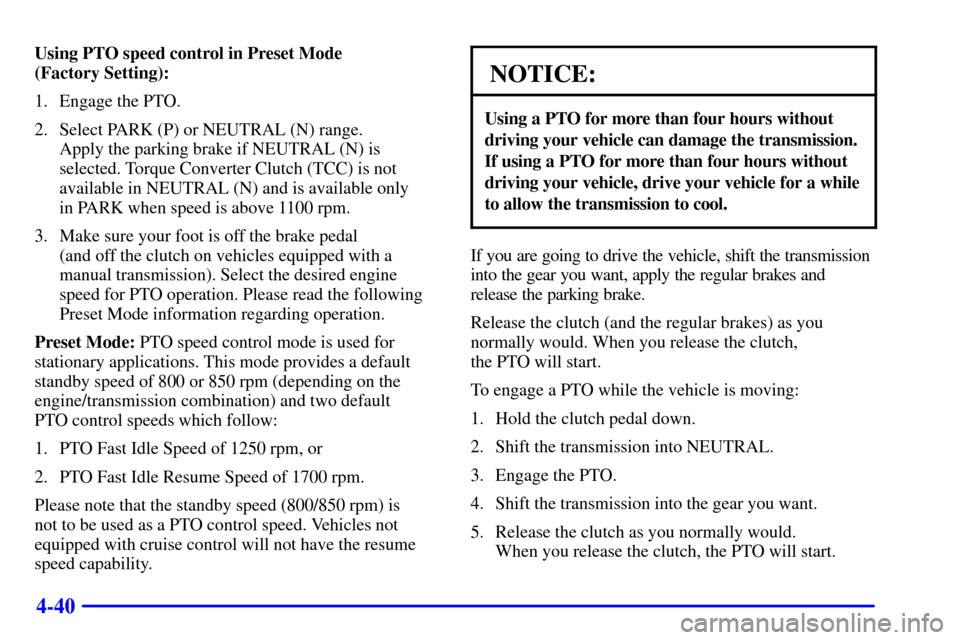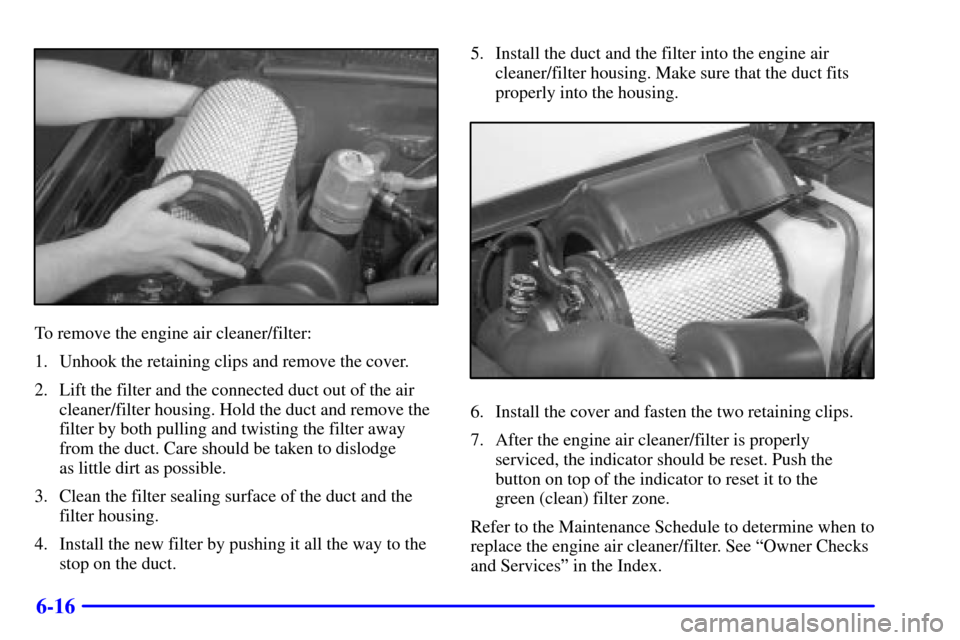Page 161 of 321

4-40
Using PTO speed control in Preset Mode
(Factory Setting):
1. Engage the PTO.
2. Select PARK (P) or NEUTRAL (N) range.
Apply the parking brake if NEUTRAL (N) is
selected. Torque Converter Clutch (TCC) is not
available in NEUTRAL (N) and is available only
in PARK when speed is above 1100 rpm.
3. Make sure your foot is off the brake pedal
(and off the clutch on vehicles equipped with a
manual transmission). Select the desired engine
speed for PTO operation. Please read the following
Preset Mode information regarding operation.
Preset Mode: PTO speed control mode is used for
stationary applications. This mode provides a default
standby speed of 800 or 850 rpm (depending on the
engine/transmission combination) and two default
PTO control speeds which follow:
1. PTO Fast Idle Speed of 1250 rpm, or
2. PTO Fast Idle Resume Speed of 1700 rpm.
Please note that the standby speed (800/850 rpm) is
not to be used as a PTO control speed. Vehicles not
equipped with cruise control will not have the resume
speed capability.
NOTICE:
Using a PTO for more than four hours without
driving your vehicle can damage the transmission.
If using a PTO for more than four hours without
driving your vehicle, drive your vehicle for a while
to allow the transmission to cool.
If you are going to drive the vehicle, shift the transmission
into the gear you want, apply the regular brakes and
release the parking brake.
Release the clutch (and the regular brakes) as you
normally would. When you release the clutch,
the PTO will start.
To engage a PTO while the vehicle is moving:
1. Hold the clutch pedal down.
2. Shift the transmission into NEUTRAL.
3. Engage the PTO.
4. Shift the transmission into the gear you want.
5. Release the clutch as you normally would.
When you release the clutch, the PTO will start.
Page 162 of 321

4-41
Using PTO speed control in Variable Mode (Mobile):
1. Engage the PTO.
2. Vehicle speed must be greater than 5 mph for vehicles
equipped with gasoline engines or greater than 0 mph
for vehicles equipped with diesel engines.
3. Make sure your foot is off the brake pedal
(and off the clutch for vehicles equipped with a
manual transmission).
4. Select the desired engine speed (with the foot pedal)
and select SET on the PTO switch or with the
cruise control.
Using PTO speed control in Variable
Mode (Stationary):
1. Engage the PTO.
2. Vehicle speed must be less than 5 mph for vehicles
equipped with gasoline engines or at 0 mph for
vehicles equipped with diesel engines.
3. Make sure your foot is off the brake pedal
(and off the clutch for vehicles equipped with a
manual transmission).
4. Select the desired engine speed (with the foot pedal)
and select SET on the PTO switch or with the
cruise control.Variable Mode: PTO speed control mode can be used
for both stationary and mobile applications. This mode
allows PTO to be controlled in a fashion similar to how
cruise control sets vehicle speed. The operator can set to
an rpm (between 800 and 2200) with the cruise control
feature or with the SET position on the PTO switch.
The operator is then able to increase rpm in increments
of 100, or ªtapº, with the resume position on the cruise
control. Or, the operator can decrease rpm in increments
of 100 with either of the SET switches on the PTO or
the cruise control. Vehicles not equipped with
cruise control will not be able to increase in
100 rpm increments.
All engine speed values listed above are factory preset
values. With the exception of the TCC lockup speed
(1100 rpm) and the ªtapº increment (100 rpm), all of
these values are programmable and can be adjusted by
your GM dealer or body upfitter. If the PTO software
settings do not match the settings shown here, then
they may have already been altered in order to satisfy
the requirements of the installed PTO system and
body equipment.
Page 199 of 321

6-16
To remove the engine air cleaner/filter:
1. Unhook the retaining clips and remove the cover.
2. Lift the filter and the connected duct out of the air
cleaner/filter housing. Hold the duct and remove the
filter by both pulling and twisting the filter away
from the duct. Care should be taken to dislodge
as little dirt as possible.
3. Clean the filter sealing surface of the duct and the
filter housing.
4. Install the new filter by pushing it all the way to the
stop on the duct.5. Install the duct and the filter into the engine air
cleaner/filter housing. Make sure that the duct fits
properly into the housing.
6. Install the cover and fasten the two retaining clips.
7. After the engine air cleaner/filter is properly
serviced, the indicator should be reset. Push the
button on top of the indicator to reset it to the
green (clean) filter zone.
Refer to the Maintenance Schedule to determine when to
replace the engine air cleaner/filter. See ªOwner Checks
and Servicesº in the Index.
Page 232 of 321

6-49 Wheel Alignment and Tire Balance
The wheels on your vehicle were aligned and balanced
carefully at the factory to give you the longest tire life
and best overall performance.
Scheduled wheel alignment and wheel balancing are not
needed. However, if you notice unusual tire wear or
your vehicle pulling one way or the other, the alignment
may need to be reset. If you notice your vehicle
vibrating when driving on a smooth road, your wheels
may need to be rebalanced.
Wheel Replacement
Replace any wheel that is bent, cracked, or badly
rusted or corroded. If wheel nuts keep coming loose,
the wheel, wheel bolts and wheel nuts should be
replaced. If the wheel leaks air, replace it (except some
aluminum wheels, which can sometimes be repaired).
See your dealer if any of these conditions exist.
Your dealer will know the kind of wheel you need.
Each new wheel should have the same load
-carrying
capacity, diameter, width, offset and be mounted the
same way as the one it replaces.If you need to replace any of your wheels, wheel bolts
or wheel nuts, replace them only with new GM original
equipment parts. This way, you will be sure to have the
right wheel, wheel bolts and wheel nuts for your vehicle.
CAUTION:
Using the wrong replacement wheels, wheel bolts
or wheel nuts on your vehicle can be dangerous.
It could affect the braking and handling of your
vehicle, make your tires lose air and make you
lose control. You could have a collision in which
you or others could be injured. Always use
the correct wheel, wheel bolts and wheel nuts
for replacement.